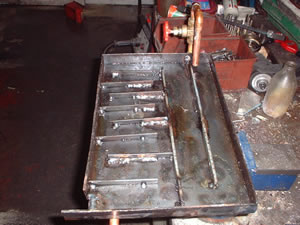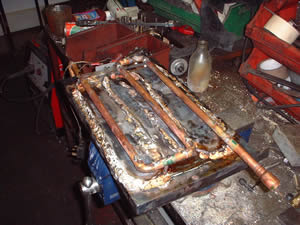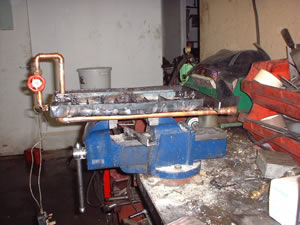


I am building a continuous biodiesel mixer. An integral part of this is a heater to remove the water before processing. This system will also work with a batch system if used between the oil store and mixer or coupled with a filter on the outlet to clean oil for SVO conversions.
Oil is pumped up to the hotplate where it is heated until the water boils off. There are a number of advantages to this compared with boiling a large batch: The heat loss is less ,due to the smaller surface area, which means a smaller heater can be used. There is the possibility of recovering the heat from the output to preheat the input whereas all the heat from a batch process is normally loss to atmosphere after the water has boiled. There is no risk of "explosions" of steam that can throw hot oil out of the container. Because it is easier to control it can be left unattended.
 |
Oil runs across the hotplate (16"x10") which is kept at 150 deg C at the rate of approx. 1 litre/minute(currently .5litre/minute until the insulation and heat recovery is fitted). The vertical baffles control the flow around the plate and provide added surface area. Most of the steam bubbles are formed where these meet the plate at the bottom. By the time the oil reaches the end of the long baffle it is at 100+ degrees and is steaming. By the time it reaches the exit it has stopped steaming - no water left. |
 |
Underneath the hotplate the oil is preheated by running through copper pipes. When completed this area will be insulated which should improve the efficiency. The heating element is a 2.4Kw grill element from www.ezee-fix.co.uk which cost just over £10. It is brazed to the bottom of the hotplate. |
 |
Once the oil is preheated it passes through the control valve onto the hotplate. It works best in this position as the flow of thick oil is difficult to control. The next step is to fit the thermostat and fit it all in an insulated box. A lid will be fitted to extract the steam, again there is the possibility of recovering heat back into unprocessed oil. |
| Please join the mailing list to be notified of the next update. | |